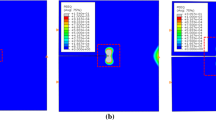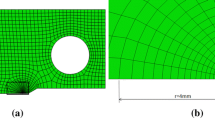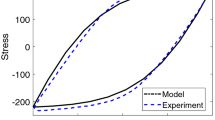Abstract
A model is developed for damage produced by the growth of isolated grain boundary cavities under power law creep. This damage model is combined with the small scale yielding stress and strain fields to predict the damage ahead of a stationary and a steadily propagating crack tip in an elastic-power law creeping material. A failure criterion, based upon the damage ahead of the crack tip attaining a critical value, is invoked. This criterion leads to predictions for the incubation time prior to initiation of crack growth and for the relationship between the remote stress intensity factor and the steady state crack speed. Results are presented for both elastic-primary and -secondary creep crack growth. In either case, there exists a minimum stress intensity factor below which steady state crack growth is not possible. Comparisons of the predictions of this model with others for steady state crack propagation in elastic-secondary creeping materials are also made.
Résumé
On développe un modèle décrivant le dommage produit par la croissance de cavités isolées aux frontières des grains sous l'effet d'un fluage selon une loi parabolique. Ce modèle d'endommagement est combiné aux champs de contrainte et de déformation conduisant à une plastification à petite échelle, en vue de prédire le dommage qui se produit en avant de l'extrémité d'une fissure stationaire et en propagation lente, dans un matériau soumis à fluage selon une loi élastique. On invoque un critère de rupture basé sur la valeur critique atteinte par le dommage en avant de l'extrémité de la fisure. Ce critère conduit à prédire le temps d'incubation avant amorçage de la croissance d'une fissure, ainsi que la relation entre le facteur d'intensité des contraintes appliquées à une certaine distance et la vitesse de croissance stable de la fissure.
On présente les résultats dans les cas de croissance d'une fissure de fluage au stade secondaire. Dans les deux cas, il existe un facteur d'intensité de contrainte minimum en dessous duquel une croissance stable de la fissure n'est pas possible. On procède également à des comparaisons des prédictions données par ce modèle avec d'autres, pour la propagation en état stable d'une fissure dans des matériaux soumis à fluage secondaire élastique.
Similar content being viewed by others
References
R.Raj and M.F.Ashby, Acta Metallurgica 23 (1975) 653–666.
T.-J.Chuang, K.I.Kagawa, J.R.Rice and L.B.Sills, Acta Metallurgica 27 (1979) 265–284.
A.F.C.Cocks and M.F.Ashby, Progress in Material Science 27 (1982) 189–244.
G.H.Edward and M.F.Ashby, Acta Metallurgica 27 (1979) 1505–1518.
A.C.F.Cocks and M.F.Ashby, Metal Science 14 (1980) 395–402.
B. Budiansky, J.W. Hutchinson and S. Slutsky, in Mechanics of Solids, The Rodney Hill 60th Anniversary, Pergamon Press (1981) 13–45.
A.Needleman and J.R.Rice, Acta Metallurgica 28 (1980) 1315–1332.
C.Y.Hui, in Elastic-Plastic Fracture, Vol. 1, ASTM STP 803, American Society for Testing and Materials, Philadelphia (1983) 573–593.
A.C.F. Cocks and M.F. Ashby, in Creep in Structure, Proceedings of the Third IUTAM Symposium (1981) 368–387.
W.D.Nix, Scripta Metallurgica 17 (1983) 1–4.
B.F.Dyson, Metal Science 10 (1976) 349.
J.R.Rice, Acta Metallurgica 29 (1981) 675–681.
A.C.F.Cocks and M.F.Ashby, Scripta Metallurgica 16 (1982) 109–114.
R.J.Dimelfi and W.D.Nix, International Journal of Fracture 13 (1977) 341–348.
D.A.Miller and R.Pilkington, Metallurgical Transactions 11 (1980) 177–180.
H. Riedel, in Creep in Structure, Proceedings of the Third IUTAM Symposium (1981) 504–515.
J.W.Hutchinson, Acta Metallurgica 31 (1983) 1079–1088.
J.B.Martin, Journal of Applied Mechanics 33 (1966) 216–217.
J.B.Martin, Journal of the Mechanics and Physics of Solids 12 (1964) 165–175.
M.F.Kanninen and C.H.Popelar, Advanced Fracture Mechanics, Oxford University Press, New York (1985).
T.C. Chang, C.H. Popelar and G.H. Staab, International Journal of Fracture, to appear.
C.Y.Hui and H.Riedel, International Journal of Fracture 17 (1981) 409–425.
C.H.Popelar and R.G.Hoagland, Engineering Fracture Mechanics 23 (1986) 131–144.
Author information
Authors and Affiliations
Rights and permissions
About this article
Cite this article
Chang, T.C., Popelar, C.H. & Staab, G.H. A damage model for creep crack growth. Int J Fract 32, 157–168 (1986). https://doi.org/10.1007/BF00018350
Received:
Issue Date:
DOI: https://doi.org/10.1007/BF00018350




